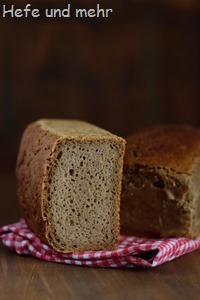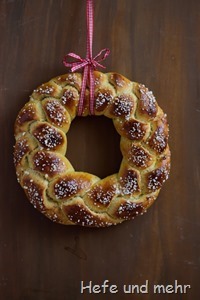![Pameln (1)[7] Pameln (1)[7]](https://www.hefe-und-mehr.de/wp-content/uploads/2019/11/Pameln-17_thumb.jpg) The second recipe for rolls from East-Germany which I found in an old Baking book from 1930 is a recipe for “Pameln”. The recipe itself was once again rather short: Use a waterdough with some rye flour mixed in. But at least the description for forming was better this time: Roll the dough into a shape similar like Berliner Schrippen and cut it length wise prior to baking.
The second recipe for rolls from East-Germany which I found in an old Baking book from 1930 is a recipe for “Pameln”. The recipe itself was once again rather short: Use a waterdough with some rye flour mixed in. But at least the description for forming was better this time: Roll the dough into a shape similar like Berliner Schrippen and cut it length wise prior to baking.
I try to research about this kind of rolls like I did it for the Salzkuchen, but I only found some posts of people looking for a recipe. And so here it is, my try on an Pameln. It is a delious roll with a soft crumb and complex flavour due to the sourdough!

 A dear reader told me last year about a speciality in the north-western Part of germany: Campingwecken (lit. Camping rolls). She descripted it as a roll filled with a mixture of roasted almonds and pearl sugar. I was intrigued and started researching. It seemed, that the variant with almond is a rare one, more commenly is a variant with only pearl sugar. I even found a bakery who offered this kind of rolls in the city of Leer in our last vacation in East Frisia, so I could try this roll.
A dear reader told me last year about a speciality in the north-western Part of germany: Campingwecken (lit. Camping rolls). She descripted it as a roll filled with a mixture of roasted almonds and pearl sugar. I was intrigued and started researching. It seemed, that the variant with almond is a rare one, more commenly is a variant with only pearl sugar. I even found a bakery who offered this kind of rolls in the city of Leer in our last vacation in East Frisia, so I could try this roll.





 A sweet treat which seems to be perfect for Easter Sunday breakfast is the traditional Aachener Streuselbrötchen (Streusel rolls from Aachen). They stem – as the name suggested – from Aachen and are not known above the city borders. And that is a pity, as they are so delicious, especially if you are a devoted streusel lover like I am. So I try today to get these rolls the national (or even international) attention they should have.
A sweet treat which seems to be perfect for Easter Sunday breakfast is the traditional Aachener Streuselbrötchen (Streusel rolls from Aachen). They stem – as the name suggested – from Aachen and are not known above the city borders. And that is a pity, as they are so delicious, especially if you are a devoted streusel lover like I am. So I try today to get these rolls the national (or even international) attention they should have.